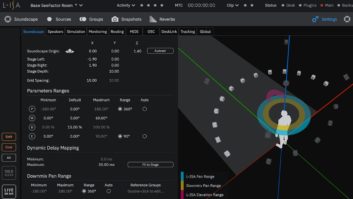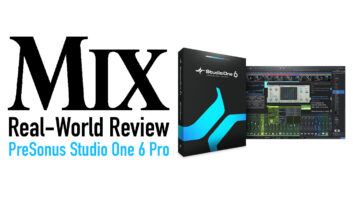
Since PMI Audio Group acquired Studio Projects, they have worked at improving upon the low-cost condenser lines being made by 797 Audio in Beijing from PMI’s designs. For starters, the 797 moniker is no longer on the body of the mic. The mics are manufactured abroad, but are designed from the ground up by PMI’s Brent Casey in PMI’s HQ in Gardena, Calif. Admittedly, I’ve become jaded through my experience with the older mics and ignorantly never really gave the SP logo much respect, until now.
EXTREME T3 MAKEOVER
The T3 ($839) has been around for some time, but recently underwent a significant aesthetic and technical update, starting with a capacitor change in the high-impedance section. Its sleek 9×2-inch, matte-silver body now has a redesigned headstock, with sweeping curves and a heavier mesh grille that delivers an understated look reminiscent of the AKG C 12, after which the T3 is modeled. At 26.9 ounces, the T3’s craftsmanship, elegant visage and rugged feel scream “classic.”
The mic uses a 1.35-inch, gold-sputtered Mylar foil capsule with an externally polarized and balanced transformer output. Its dual 6-micron diaphragms are coupled through a minimalist tube circuit designed around a hand-selected 12AY7 (6072) “dual-triode” tube, chosen for its traditional warm sonic character and low noise. Pattern control is variable between omni, wide cardioid, cardioid, supercardioid, hypercardioid and figure-8, as well as all intermediate settings, via a 9-position switch on the remote 110/220VAC power supply.
There are no switches on the mic, nor a pad or low-cut filters on the supply. Frequency response is listed as 20 to 20k Hz, and its 18dBA self-noise equates to a signal-to-noise ratio of 76 dB, which is typical for modern, large-diaphragm condensers. Sensitivity is also good at 14 mV/Pa = -37 dB (0 dB = 1V/Pa), with a 125dB max SPL. The T3 ships in a rugged aluminum case, with a lengthy gold-plated 7-pin cable, suspension shockmount and foam windscreen.
UP TO THE CHALLENGE
I ran the T3 and an AKG C 12VR, for comparison, through a Millennia HV-3C preamp and an Apogee Rosetta 800 converter, recording both simultaneously to Pro Tools HD at 48kHz/24-bit. After allowing seven days of “burn-in” before listening critically, I detected that the T3 was about 4 to 5 dB hotter than the C 12, so I matched levels using the HV-3C’s 1.5dB gain steps.
With both mics set to cardioid and pointing up the neck at the classic 12th-fret position, a Martin OM-28 Vintage Reissue was up first. Immediately detectable as sweet and round without any boxy resonance, the T3’s highly controlled character, exquisitely smooth top end, and minimal off-axis coloration performed admirably, similar to much pricier small-diaphragm condensers often used in these recording situations. Unlike the C 12 with its prominent low end, the T3 was easier to place with almost instantly gratifying results — capable of getting in tight for strong room isolation. Even when directed toward the sound hole for warmer body tones, it never became boomy. I could achieve any sound I wanted simply by maneuvering the mic, without resorting to EQ. The tonal balance was remarkably even. The mic was also considerably quieter than the C 12. Indeed, the T3’s circuit design uses as few components as necessary to minimize self-induced noise and coloration.
When tossed into a room with several different styles of guitar amps, the T3 stood up to their assault, handling each very well. In the past, I’d often mike dual speaker cabinets with a dynamic and a condenser, blending or choosing between sources at mixdown, yet the T3 delivered a surprisingly well-integrated and modern tone, offering a nice balance of crunch and warmth.
Not having a matched pair to test with, I proceeded to the drum kit by spot-miking pieces individually and later positioning the T3 with the C 12 in a stereo overhead configuration, strictly for clone-comparison sake. Used direct, the mic solidly captured mid- and floor toms when mounted face-down about two to three inches from the top heads, though it didn’t fare so well inside the kick drum, blowing out when I went for a more clicky sound and aimed it two inches from the batter head. Bottom-snare and hi-hat miking delivered crisp attacks with strong, smooth presence in the decay, with none of the brittle behavior you might expect with mics in this price range. When compared as overheads, the two played very close matches, except that the T3 had a slightly more emphatic 6 to 10kHz range, albeit an extremely smooth one.
The T3 imparts a little more sibilance on vocals than the C 12, but this can also directly equate to increased clarity for some vocalists, such as louder and more powerful singers. In particular, female pop vocals shined on the T3, while quiet and “noisy” vocalists may not benefit from the exaggeration. The slight bump also tends to make the T3 more present and impressive-sounding than the C 12, though not artificially so. There are no “specialized marketing” frequency spikes or other trick curves here. The highs are simply gorgeous with smooth and natural “air” for miles.
On male vocals, the AKG’s famous lows aren’t as pronounced with the T3, which may need some EQ. I’ve always found the sweet spot for vocals on the C 12 to be rather small, tending to sit somewhere between eight to 10 inches from the capsule, which seems to lessen the trademark thickness in its bottom end. On the T3, however, you can be anywhere from three or four inches to well past a foot and still sound like a million bucks.
MY CUP OF T
I love this mic. Is it a spot-on C 12 clone? Not really. Although it’s certainly of the same ilk, I believe that the T3 is actually better-sounding in most cases. With a cleaner signal path, flatter response, extended bottom, much more forgiving proximity effect and off-axis response, plus admirable tolerance for high SPLs, the T3 will surely be put to work in many traditional and untraditional scenarios, including those where you wouldn’t dare place a $7,000 to $10,000 microphone.
Knowing its street price is closer to six bills, I’d never have expected this to be a first-class vocal mic. However, I wouldn’t hesitate for a moment to use the T3 on a crucial lead, having switched out the AKG at many points during my review in favor of the T3’s more present and flattering handling of a powerful female R&B vocalist. Highly animated on her toes, even when she’d “test” the sweet spot, her performance remained extremely even and upfront — a feat nearly impossible when tethered to the C 12. On any vocal or instrument, the T3’s tube circuitry imparts a wonderfully warm, transparent yet naturally defining character, without sounding hyped or colored-to-purpose in any way. This, together with its nine switchable pickup patterns, lends to its extraordinary versatility in tackling the soup-to-nuts of any studio session.
Whether you already own a mega-bucks mic and are looking to complement it with a different personality and something you can be more adventurous with, or you’re searching out a primary mic with vast potential, the T3 probably represents one of the best microphone values on the market.
Studio Projects, 877/563-6335, www.studioprojectsusa.com.
Jason Scott Alexander is a producer/mixer/remixer in Ontario, Canada.







